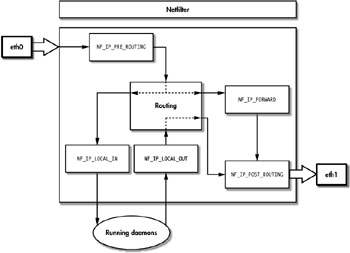Netfilter
Every packet coming into the system off the network cable is passed up through the protocol stack, which converts the electronic signals hitting the network interface card into messages the services or daemons can understand. When a daemon sends a reply, the kernel creates a packet and sends it out through a network interface card. As the packets are being processed up (inbound packets) and down (outbound packets) the protocol stack, Netfilter hooks into the Linux kernel and allows you to take control of the packet's fate.
A packet can be said to traverse the Netfilter system, because these hooks provide the ability to modify packet information at several points within the inbound and outbound packet processing. Figure 2-1 shows the five Linux kernel Netfilter hooks on a server with two Ethernet network interfaces called eth0 and eth1.

Figure 2-1: The five Netfilter hooks in the Linux kernel
The routing box at the center of this diagram is used to indicate the routing decision the kernel must make every time it receives or sends a packet. For the moment, however, we'll skip the discussion of how routing decisions are made. (See "Routing Packets with the Linux Kernel" later in this chapter for more information.)
For now, we are more concerned with the Netfilter hooks. Fortunately, we can greatly simplify things, because we only need to know about the three basic, or default, sets of rules that are applied by the Netfilter hooks (we will not directly interact with the Netfilter hooks). These three sets of rules, or chains, are called INPUT, FORWARD, and OUTPUT (written in lowercase on Linux 2.2 series kernels).
| Note | This diagram does not show packets going out eth0. |
Netfilter uses the INPUT, FORWARD, and OUTPUT lists of rules and attempts to match each packet passing through the kernel. If a match is found, the packet is immediately handled in the manner described by the rule without any attempt to match further rules in the chain. If none of the rules in the chain match, the fate of the packet is determined by the default policy you specify for the chain. On publicly accessible servers, it is common to set the default policy for the input chain to DROP[2] and then to create rules in the input chain for the packets you want to allow into the system.
[2]This used to be DENY in ipchains.
EAN: 2147483647
Pages: 219
- The Second Wave ERP Market: An Australian Viewpoint
- Enterprise Application Integration: New Solutions for a Solved Problem or a Challenging Research Field?
- The Effects of an Enterprise Resource Planning System (ERP) Implementation on Job Characteristics – A Study using the Hackman and Oldham Job Characteristics Model
- Healthcare Information: From Administrative to Practice Databases
- Development of Interactive Web Sites to Enhance Police/Community Relations